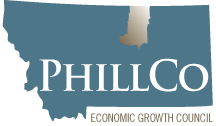
Photo: Courtesy of Martha Mintz, The Furrow ©2019
Phillips County’s very own Marko Manoukian was interviewed about the St. Mary River Diversion system and the Milk River Project for the January 2020 edition of The Furrow. This irrigation system and the impact it has on the Milk River Basin are a big deal. Read the full article at this link.
In the Fall of 2019 the PhillCo Economic Growth Council submitted a Montana Growth Through Agriculture grant on behalf of the St. Mary Rehabilitation Working Group to repair limited portions of the St. Mary River Siphon structure.
The Milk River Joint Board of Control also submitted a grant application to Montana’s Growth Through Agriculture Program to replace Drop 2.
As of this writing, both grant applications have passed the first review step. After project presentations to the Growth Through Agriculture grant review committee in early February, awarded grant projects are expected to be announced in March 2020.
About the St. Mary River Diversion System
St. Mary River Diversion Facilities is a 29-mile conveyance system built between 1907 and 1939, after being authorized in 1903 by the newly created U.S. Reclamation Services.
Diversion structures include a diversion dam, a 2-barrel river siphon crossing the St. Mary River, and a series of 5 drop structures. All diversion structures are completely within the Blackfeet Reservation in Glacier County, Montana.
About the Milk River Project
The St. Mary Milk River Canal and Conveyance infrastructure is approximately 200 miles long, beginning below the Fresno Dam and Reservoir (west of Havre, MT) and extending to Nashua MT.
The original intent of this infrastructure was to supply supplemental irrigation water to farms and ranches along the Milk River. There are approximately 140,000 irrigated acres below Fresno Reservoir who are served by the water: 8 irrigation districts, the Fort Belknap Indian Irrigation project and private irrigation.
Over the years, this supplemental water irrigation use has expanded to also become a municipal, rural, industrial, recreation and wildlife project, supplying water to Havre, Chinook, Harlem, Port of Piegan, Hill County Water Supply, Fort Belknap Agency, and the North Havre Water Supply communities as well as Bowdoin National Wildlife Refuge.
The Milk River Basin has a regional economy that is anchored in agriculture. In 2007, the agricultural product value of the 5 counties that make up the Milk River Basin was $354.9M. Without the St Mary Milk River Canal and Conveyance infrastructure, the regional impact of a lack of irrigation water would be a roughly 50% reduction in agricultural production value.
The St. Mary River Diversion Facilities structures are 100 years old and as you can imagine, in dire need of repair. Will these grants be awarded? Of course, no one can say for sure. But everyone working on this project, including Senator Mike Lang, is hopeful.
We will keep you posted on the grant’s outcome as soon as we find out.
Learn More About The St. Mary Rehabilitation Project
You can learn more at the Montana Department of Natural Resources & Conversation website.
Follow these links to view maps and historic and recent photos.
